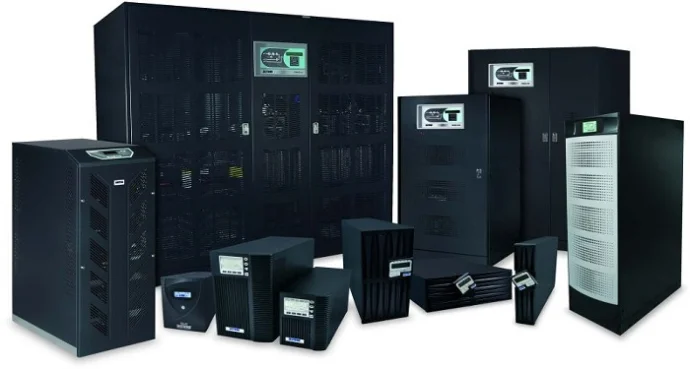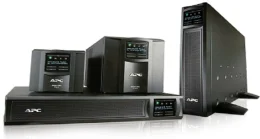Single and Three Phase UPS Systems
Whenever you are designing a new server room facility or adding additional IT kit to an existing one you need to be aware of the existing electrical infrastructure as well as the loads you expect to connect. The electrical infrastructure within a building can be traced back to a building incomer and this will be supplied externally to the building via a grid transformer.
The building incomer will be connected to a HV/LV switchboard arrangement and then distributed throughout your building by a number of sub-distribution boards. Whilst the building income may be a three-phase supply (larger buildings) this could be split into single phase supplies by an LV switchboard to provide a single-phase supply to those parts of the building requiring at 230Vac 50Hz supply. Where a three phase 400Vac 50Hz supply is required, there is no need to convert the supply from the LV switchboard.
Retail buildings, datacentres and industrial sites typically have a three-phase electrical supply to deliver the required amperage to the building. Smaller sites including offices, server rooms and homes may only have a single-phase supply.
Attention also must be given to the load profile. The power supply within the server may be single or three phase types and have for added resilience, A and B input supplies. Whilst a single-phase mains supply can be converted back into a three-phase supply, this is standard practice and a special type of single to three phase converter uninterruptible power supply is required.
Without a review of your electrical infrastructure, electrical circuits can be overloaded, heat-spots can develop within LV switchgear and sub-distribution points and potentially critical loads left without backup power during a mains power failure. These factors are assessed by our electrical contracting engineers during a site survey.
A UPS site survey is a multi-stage review process that will review the building incomer size, LV switchgear, sub-distribution boards, spare ways in existing consumer units, power distribution and load profile demands. With this information, our projects team can provide a complete power continuity plan, detailing not just the electrical works required but also a correctly sized UPS system, maintenance bypass and power distribution unit (PDU) arrangement.
UPS Input and Output Connections
When selecting an uninterruptible power supply for a critical load, there can be up to three potential configurations to review. These include arrangements known as 1/1, 3/1 and 3/3 and arise because of how a 3-phase electrical supply is configured.
A three-phase electrical or generator supply is a combination of three single phase supplies with a neutral connection, connected at 120° phase rotation between them. This allows a three-phase electrical supply to deliver more combined real power (amperage) than a single-phase supply. An analogy is a rowing boat team of three versus a one-person team. In the three-person team at least one oar is in the water at any one time.
When considering UPS configurations, we have already mention 1/1, 3/1 and 3/3 as possible arrangements. A single-phase output UPS system will be either a 1/1 or 3/1 arrangement and the input side of the configuration may be settable at installation using a jumper setting. This is preferable to a factory built option which may be available but on a longer lead time. A three-phase output system will have a three-phase input.
In terms of power ratings, it is not common to find UPS systems above 20kVA offering a single-phase output supply. This is in the main due to Ohms law and the size of cable required to overcome losses and delivered the required electrical amperage. At 20kVA the single-phase output amperage is over 86Amps and the cable is more difficult to bend and handle form a termination point of view.
When selecting a UPS, it is important also to understand the terminology used. Below 10kVA it is common for a UPS to be considered as a single-phase input and output UPS system unless a 3/1 (three phase input) configuration is specified. When a three phase UPS is required it is important to note whether the power required in Amps, kVA or kW is the total required or per phase. If per phase, the three individual sums need to be added together to achieve a total three phase requirement.
As an example, if the output required is 20Amps per phase the calculation is:
(20Amps x 230Vac) = 4600VA per phase x 3 = 13800VA or 13.8kVA.
Centralised and Decentralised Power Protection
Most large facilities will have a 3-phase electrical incomer from the local distribution transformer. The three phase circuits supply a large amount of electrical power for critical loads and will be connected to the building via an LV switchboard.
At this point of connection within the building, it is may be possible to install a 3-phase UPS system and adopt a centralised power protection plan. Here the UPS system is used to supply critical power circuits within the building i.e. for server room loads. The UPS system may also be backed-up by a standby power generator.
For some installations, the UPS systems may be deployed in an alternative arrangement known as a de-centralised power protection plan. Here the UPS are installed closer to the loads to be protected. The uninterruptible power supplies may supply a complete room or be installed within individual server racks.
UPS System Mains and Load Connections
Another point to consider for single and three phase UPS systems is their connections. Wall power sockets are typically 230Vac 50Hz in the UK and rated up to 13Amps. Above this a special type of plug and socket arrangement is available known as a ‘Commando’ socket and this can allow power ratings up to 16Amps. Above 16Amps the connection is normally hardwired.
The power rating available and connection choice should be known as this will also help to guide UPS selection and/or highlight any required electrical works. UPS systems up to 2kVA tend use plug in power cords. 3kVA can use Commando sockets or be hardwired. 5kVA UPS systems and above tend to be hardwired. These sizes of UPS system may be tower floor standing models or designed for 19inch rack mount installation inside a server cabinet. Three phase output UPS systems can be tower units or rack mount with some modular systems capable of installation inside the server cabinets themselves either with built-in battery packs or external battery cabinets or stands.
Consideration also needs to be given to load connections and bypass arrangements. The final critical server loads may be connected via PDU arrangement or connected via power cords directly to the UPS output power sockets. The connections can also be hardwired, normally via some form of sub-distribution board.
A UPS maintenance bypass could also be considered as part of the electrical installation. The bypass allows the uninterruptible power supply to be isolated and maintained or removed from the electrical circuit without disruption to the critical load. Of course, the maintenance bypass must be matched to the UPS power rating and input/output electrical connections to operate correctly.
Where additional battery runtime packs are installed to provide extra backup time, these may also have their own AC powered battery chargers. These may be run separately to the battery charging circuit built-into the UPS system and will therefore require their own electrical connection.
Server Room Environments can supply a centralised or decentralised uninterruptible power supplies arrangement. As well as providing a complete power protection design service, we also provide a complete electrical contracting service whether you need a plug-in single-phase UPS system or hardwired three-phase uninterruptible power supply.

























